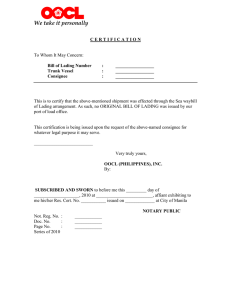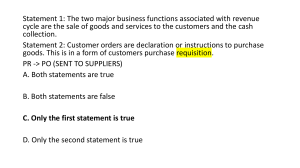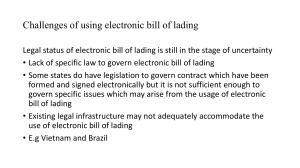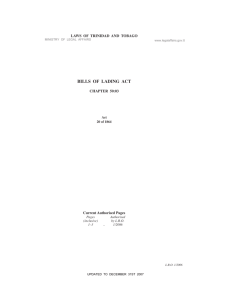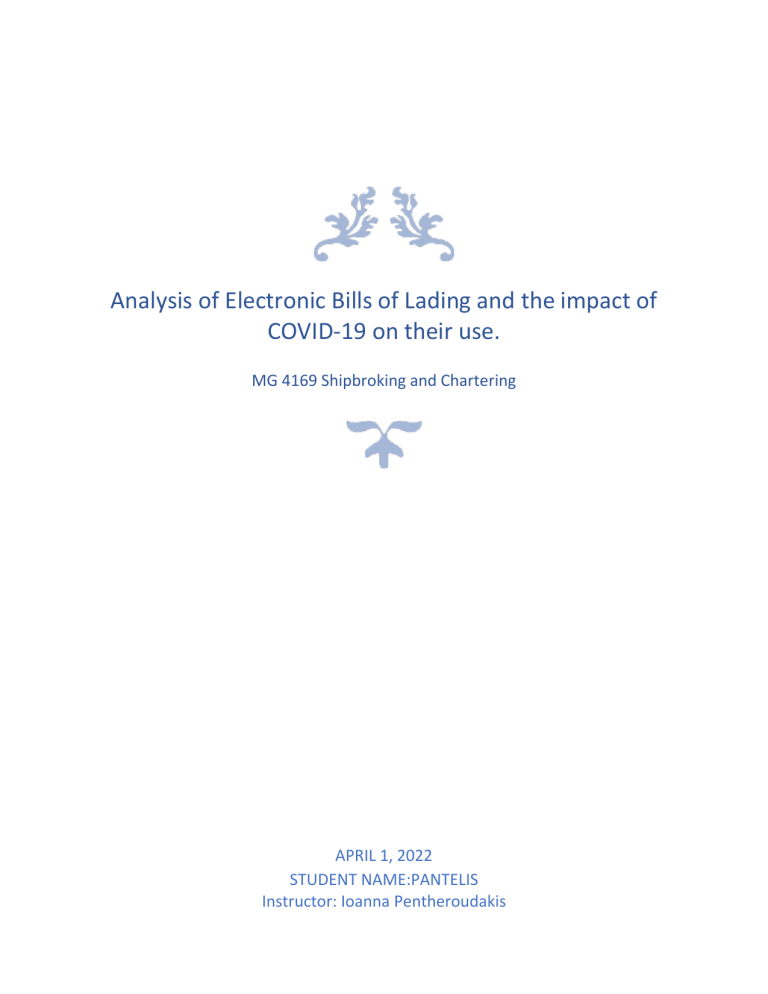
Analysis of Electronic Bills of Lading and the impact of COVID-19 on their use. MG 4169 Shipbroking and Chartering APRIL 1, 2022 STUDENT NAME:PANTELIS Instructor: Ioanna Pentheroudakis Table of Contents Page 2……………………………………………………………………………………………….………..…………………Introduction Page 2………………………………………………………………………………..……..……..Evolution of the e-Bill of Lading Page 3……………………………………………………………………………………………..Issues that prevent use of E-BoL Page 3………………………………………………………………………….Developments that support the use of E-BoL Page 5………………………………………………….……………….…………Current role of E-BoL during the Pandemic Page 7…………………………………………………………………………………………………………………………….…Conclusion Page 8…………………………………………………………………………………………………...………………………..Bibliography 1 Introduction A bill of lading (BL or BoL) is a legal document issued by a carrier to a shipper that details the type, quantity, and destination of the goods being carried. A bill of lading also serves as a shipment receipt when the carrier delivers the goods at a predetermined destination (Thompson, 2022). Throughout the history of Bills of Lading there has been a vast improvement in how Bill of Lading’s are presented and used from the late 90’s up to the modern day. The focus of this academic report will be an analysis of the Electronic Bills of Lading and how COVID-19 has impacted their use. Furthermore, a short history regarding the evolution of Bills of Lading will be provided, the issues that arise with the use of e-Bills of Lading will be viewed, and a general overview of the developments that support the use of this specific type of Bill of Lading will be presented. By the end of the report the aim is to present a full comprehensive depiction of Electronic Bills of Lading from all aspects. The Evolution of e-Bills of Lading from its beginning in the Late 1990’s up to the Modern Day To begin with we must first introduce and mention the actual functions the Bill of Lading (BoL) serves. It is one of the most crucial legal documents governing the transportation of goods by sea. The BoL constitutes the receipt for the goods or cargo transported while it is a transferable proof of title to the goods allowing the holder to claim them. Also, it is a documentation describing the conditions of the transportation. Since its conception the BoL was issued and used by the various parties in hard copy format. The first marine regulations are believed to be the Rhodian sea rules, which date all the way back to 900 BC (Hendrikse et al., 2008). The BoL originated when commodities were entrusted to the master of a vessel as the carrier bailee. There were disagreements between shippers and carriers regarding the nature and quantity of the cargo, and therefore a clerk was hired to escort the goods, who was required to swear and register the quantity and character of the commodities. This sworn clerk was seen as evidence of receipt of goods, and there is evidence that this practice stretches all the way back to 1063(Hendrikse et al., 2008). Over the years and as technology advanced and trading was moving into a more digital area the industry tried to adopt and use an electronic version of BoL. The history of electronic bills of lading, which began in the 1980’s with a push inside the oil business, has adequately proved an inherent conservatism within international trade. Bolero, a joint venture between Swift, the interbank payments mutual, and the TT Club that started in 1998 but failed to break into the industry 2 despite significant investment, intense promotion, and years of work, was launched in 1998 (Bolero, 2021). Eventually e-Bills managed to be incorporated in the shipping industry and in particular in the dry bulk and container market. Obviously the e-Bill continued to serve the exact same purpose and its functions remained unaltered which are stating the legal rights and obligations of the e-Bill holder in connection to the cargo, contain or attest to the carriage contract and its provisions, serve as a receipt for the shipper's cargo being delivered to the carrier (Choi, 2019). This is just a brief overview of how the Bill of Lading has evolved over the years. Issues that Prevent the use of e-Bills of Lading E-Bills were the most difficult to dematerialize and make it digital since they are utilized by parties other than the contracting party in industries wholly unrelated to the contracting party. Banks use it for financing, regulatory bodies use it in some instances, and it is cross-industry: it is a critical document in both the physical and financial supply chains. Uncertainty about the legal legitimacy of eBLs contributes to some of the reluctance to adopt them. Due to the fact that only a small number of jurisdictions accord electronic trade documents the same legal standing as their paper equivalents, commercial eBL solutions have had to circumvent this limitation through contract law – in which both parties agree that the eBL is similar to a paper BL (Manson, 2022). The issue is that, in general, international trade does not include point-to-point parties. While a carog is moved via ship from A to B, the likelihood is that the ship owner is from C, the contract of carriage is governed by D law, and finance is facilitated by E and F governments. When there are gaps in legislation recognizing electronic documents, as there are today, a multiparty agreement is required. Another impediment has been interoperability. With multiple competing systems on the market, stakeholders are unsure where to commit, and with each solution based on a unique format and technological setup, the change management process and associated expenses associated with switching horses’ mid-race have dissuaded many from adopting the eBL (Manson, 2022). However, the emergence of Covid resulted in a complete shift in attitudes since this pandemic demonstrated that paper-based physical and financial supply networks are inherently fragile and prone to failure. Throughout the next few sectors this exact shift in attitude will be presented and further analyzed. 3 Developments that Support the use of e-Bills of Lading After almost two years from the Covid-19 pandemic outbreak , any remaining reservations about going paperless appear to have been vanished entirely. As lockdowns paralyzed in-person encounters and hampered the processing and transit of papers, trade digitization – which has been attempted unsuccessfully for three decades – suddenly gained the kind of political capital its proponents could only have imagined. The approval of the UNCITRAL Model Law on Electronic Transferable Records (MLETR) by Asia's trading hub Singapore was immediately followed by a ministerial declaration by the G7 nations that they would begin working on legal reforms to remove obstacles to electronic instruments in commerce (Radchenko, 2021). Meanwhile, standardization – a critical impediment to the widespread use of digital documents – gained significant pace as players from all sectors of the business convened to negotiate common ground. "Covid was the spark that ignited everything," says Thomas Bagge, CEO of the Digital Container Shipping Association (DCSA), a trade association comprised of nine of the world's major container shipping companies, who collectively account for 70% of global containerized trade. "A sizable number of parties are now driven to modernize the opaque and outmoded methods that continue to prevail in international trade. I anticipate that a great deal of change is currently occurring" (Radchenko, 2021). One of the first endeavors into digitizing these physical documents centered on the bill of lading (BL), arguably the most essential piece of paper in seaborne commerce. If an original bill of lading is lost, delayed, or stolen, the recipient is unable to take control of the cargo, and with around 90% of traded products transported via the waves, digitizing the BL would have far-reaching consequences. Six years after the unsuccessful attempt of the first E-bill and in particular during 2005, Bolero's first competitor, essDocs, entered the market with their eBoL in 2010. By February 2020, the International Group of P&I Clubs (IGP&I), which covers approximately 90% of the world's ocean-going tonnage, had agreed to cover cargo carriage liabilities under six electronic systems: Bolero, essDocs, Singapore-based eTitle, and blockchain-based newcomers edoxOnline, CargoX, and Wave (Manaadiar, 2022). 4 Current Use/Role of e-Bills of Lading during the Pandemic Let the focus now shift to the current role of these modern age bills in today’s day and age, during the pandemic. Firstly, let us have a brief overlook on the advantages and disadvantages for this particular type of Bill of Lading. E-Bills have a lot of advantages, including the following: Speed: Because an E-Bill may be transferred quickly, a bill of lading can transit through numerous hands and still be at the discharge port when the vessel arrives, obviating the necessity for (and cost of) letters of indemnity. Speed can be a key and make matters much easier when it comes to this matter (Fulbright, 2022). Administrative costs: The convenience of electronic transfer eliminates major administrative costs associated with paper-based transactions. As is apparent, digital correspondence will be cheaper than the constant paper trails that the previous form consists of. Dealing with errors: Because E-Bills can be readily cancelled and reissued, they reduce the costs and time associated with dealing with unavoidable errors. It is much easier to amend an error digitally than it was in the past. Reduced likelihood of fraud: In one way, the danger of fraud is mitigated via audit trails, electronic signatures, and PIN numbers, which make forging an E-bill more difficult. However, electronic systems also face additional threats, such as those posed by hackers (as highlighted in MSC Mediterranean Shipping Company v Glencore [2017] EWCA Civ 365, where the PIN for an electronic delivery system appears to have been misappropriated by a cyber-attack) (Fulbright, 2022). Having said that, beyond cyber security, there are several roadblocks that E-Bills must overpass. One of the most critical is how to reproduce the legislation and regulations that govern a paper bill of lading in electronic form to ensure functional equivalency of the E-Bill. In terms of negative points, one could consider the following points- Many are hesitant to join up in this form of BoL because they are concerned whether some jurisdictions, particularly those that need a high level of formality (e.g. Indonesia and India), will accept E-Bills. This implies that, while E-Bills are theoretically accepted in a wide variety of jurisdictions, some users are exploring their use in more developed markets. Additionally, there is a general aversion to change in the market; many users are content with the current paper method (despite there being plenty of room for improvement). 5 Naturally, there are legitimate concerns about hacking/cybercrime dangers, as demonstrated in the Glencore example described previously (Fulbright, 2022). These issues are apparent and just like any form of technological advancement these types of BoL are susceptible to security breaches which can lead to huge issues for the party involved. Finally, let’s take a real look at the role of this e-Bol during the pandemic. Due to the global lockdown imposed by COVID-19, export clients are severely restricted from obtaining original bills of lading once the cargo has been carried on board. Similarly, if cargo arrives/arrives at a port of discharge during the lockdown period, importers may not receive the original bill of lading on time or, worse, may lose the original bill of lading. Several lines have been advertising their electronic bill of lading, which some lines believe is the ideal solution for the current COVID-19 scenario. A great way to see how this specific BoL provides solutions to companies is the modern case study of ZIM Israel, a large liner company who deemed that it was time to make some changes in terms of how they use and apply their Bill of Ladings. Nir Avni, Managing Director of ZIM Israel, stated in a news release, "Especially in light of the current Coronavirus epidemic, the capacity to digitally transmit original documents between parties, thereby displacing traditionally physical processes, is critical." ZIM is a market leader in delivering these solutions. We have completed the integration of Wave with ZIM's legacy system following our successful collaboration with Wave since 2018. We've virtually reduced the time required for document transfer from days to a few minutes" (Manaadiar, 2022). In November 2017, ZIM Line announced the successful completion of the first trial of paperless bills of lading using blockchain technology in collaboration with Sparx Logistics and Wave Ltd. ZIM recently advanced electronic bill of lading technology by launching a fully functional e-B/L issued from its legacy system. "The Wave technology that enables the process is designed to replicate the issuance of original paper documents and associated processes in an entirely digital format that conforms to recognized and practiced legal standards in the international trade industry, thereby reducing inefficiencies, risks, and losses," the press release continued. CMA CGM, the world's fourth largest container shipping company, recently announced the availability of electronic bills of lading on its eBusiness platforms (Manaadiar, 2022). According to CMA CGM, another huge container shipping company, the "Paperless Bill of Lading performs the same tasks as a conventional paper Bill of Lading." Electronic bills of lading can be transacted digitally, safely, and securely in a manner similar to that of paper bills of lading, except that 6 there is no physical movement of the document (Manaadiar, 2022). So, as it is apparent from the example above, there are several advantages of this transition to the electronic form, which present an interesting transition in the troubling times that we are living with the COVID-19 pandemic. Conclusion Shifting completely to a paperless electronic bill of lading may well not be easy due to a number of considerations. Not only from an insurance standpoint, shipping lines and consumers should verify that all other parties to bill of lading transactions, such as banks, chambers of commerce, and cargo insurers, accept electronic paperless bill of lading. Many nations have legislation allowing contracts to be produced and signed electronically in the contemporary global commerce environment, but the legal status of the electronic bill of lading appears murky to many. COVID-19 will be cured in coming time, but ideally the weakness that COVID-19 exposed in regards of a bill of lading will motivate more people to seriously consider electronic bill of lading. Additionally, once the UNCITRAL model law is implemented, it should aid the industry in developing a clear understanding of the rights and obligations of those wishing to employ electronic paperless bills of lading. Nevertheless, this shift to the electronic form is definitely an intriguing prospect that will have a lot of large companies considering their options when it comes to Bill of Ladings, since as we have seen throughout this academic report there are serious advantages to using the electronic form. At the end of the day in the modern day and age we live in and with all the difficulties the world is currently facing it seems that in most industries companies are shifting all their solutions to digital ones, so one could assume that this will be no different in this specific case of BoL’s. Word Count: 2569 words 7 Bibliography 1.) Thompson, J. (2022). What is bill of lading? Freightquote. Retrieved March 28, 2022, from https://www.freightquote.com/how-to-ship-freight/bill-of-lading/ 2.) Rragg, E. (2021). How the electronic bill of lading became a battleground for trade digitisation. Global Trade Review (GTR). Retrieved March 30, 2022, from https://www.gtreview.com/magazine/volume-19-issue-3/electronic-bill-lading-becamebattleground-trade-digitisation/ 3.) Zekos, G. I. (2018). E-bills of lading contracts in Global Transportation. Nova Science Publishers. 4.) Kuester, F. (2018, September 4). Electronic bill of lading – how is paperless trade possible? Combined Transport. Retrieved March 27, 2022, from https://combinedtransport.eu/electronic-bill-of-lading 5.) Bolero. (2021, June 4). Electronic bills of lading. Bolero. Retrieved March 31, 2022, from https://www.bolero.net/what-is-an-electronic-bill-of-lading/ 6.) Hendrikse, M. L., Margetson, N. H., & Margetson, N. J. (2008). Aspects of maritime law: Claims under bills of Lading. Kluwer Law International. 7.) Manaadiar, H. (2022, March 7). Coronavirus Covid-19 and Bill of Lading. Shipping and Freight Resource. Retrieved April 1, 2022, from https://www.shippingandfreightresource.com/coronavirus-covid-19-and-bill-of-lading/ 8.) Radchenko, A. (2021). Electronic bill of lading (eBoL, EB/L): A key to improving the efficiency of global trade. Youredi. Retrieved March 19, 2022, from https://www.youredi.com/blog/electronic-bill-of-lading-ebol-a-key-to-improving-the-efficiencyof-global-trade 9.) Manson, J. (2022). TradeLens EBL: The trusted digital bill of lading. TradeLens eBL | The trusted digital Bill of Lading. Retrieved March 22, 2022, from https://www.tradelens.com/products/tradelens-ebl 10.) Choi, S.-B. (2019). Bill of lading problems in oil trade and Blockchain Bill of lading as electronic bill of lading. The Journal of Internet Electronic Commerce Resarch, 18(5), 269–288. https://doi.org/10.37272/jiecr.2018.10.18.5.269 8
